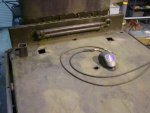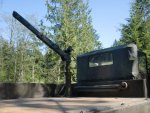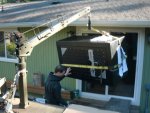Capt Jon,
I can't agree with you more, honestly. The dangers of this should've been more clearly addressed. I'd like to elaborate on a couple of your points and add some information, all while not coming off as defensive.

While I'm not in the overhead profession, I'm around it everyday and have to learn the safety and rules of proper picking on anything from 150 ton cranes to a pallet jack. I work for a company that is heavily regulated by the government and that has no problem teaching you how to do things the safe way. I'll use this knowledge to make some observations and put some information on the table.
Let's start with the crane itself before modifications were made. The crane itself, while having a claimed rating, is no more rated than the coat hangers in my closet. At best it is a copy of a design that
might have had some credentials behind it. The only thing square on mine is the square stock that was manufactured at the mill. The holes are not square, the cuts and welds are not square and there are hot and cold welds all over. Any company with slight legal knowledge would run from this device.
The stock or aftermarket hydraulic cylinders have no legal lifting rating. There are no safety check valves to keep the boom in place if an internal seal fails. The base plate for the cylinder is cast which is something not recommended in lifting devices except under special circumstances. Casting leaves too many imperfections which is why most certified lifting devices are fabricated.
You are absolutely correct about the winch. A lifting hoist will have a positive engagement brake. It will also have a rated capacity instead of a stated capacity. The chain or cable will be separately proofed or rated and most, not all, will be designed for hanging overhead from a rated attachment point.
So I'll back up your question about the safety of this device by saying that technically this device is not rated to safely pick anything, by industry standards. Having said that though, if it was rated, the customer base they are entertaining would no longer be able to afford it.
So why'd I buy this hunk of bad welds and crooked metal then? It's limitations are clear as a bell, it was hot dip galvanized (it's hard to paint the inside of a tube) and I don't have a bunch of kids to stand around and help me get stuff into the bed. Last but not least, it was affordable.
The winch is wireless and works up to a tested distance of about 40' away. The hydraulic cylinder is operated by air from a 10' hose lead. I use a rope to swing the load from the ground or in the bed.
You should never stand where you could be contacted by a load and taglines should be used to control a load. My modifications have allowed me to meet these two criteria. You should always recognize the limitations of your equipment and operate within them.
As I said, my intent here is not to defend, but answer your question and oblige your request.
Hope I've helped.











